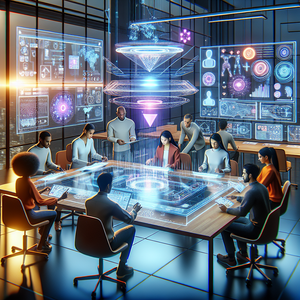Beyond Charts: The Future of Data Visualization

This section discusses the latest trends shaping the field of data visualization.
1. Augmented Reality (AR)
One of the most exciting trends in data visualization is the integration of augmented reality. AR technology has the potential to revolutionize how users interact with data by placing it in a three-dimensional space, enabling a more intuitive understanding of complex datasets. Companies like Microsoft and Google are at the forefront of this trend, developing AR applications that allow users to visualize data sets overlaid in the real world. For instance, in the healthcare sector, AR can visualize patient data and anatomical information in real-time, acting as a valuable tool for doctors during surgeries or complex diagnoses. By projecting crucial data directly onto a patient’s body, medical professionals can make quicker, more informed decisions, ultimately improving patient outcomes. The immersive nature of AR enhances user engagement and fosters a deeper emotional connection to the data being analyzed, potentially leading to better decision-making.
2. Interactive Dashboards
The evolution of interactive dashboards represents another significant trend reshaping the field of data visualization. Unlike static charts and graphs, interactive dashboards offer users the ability to manipulate data visualizations in real-time, creating a more personalized experience. These dashboards can incorporate features such as drill-down capabilities, filters, and dynamic graphs that react to user input. Businesses are increasingly adopting interactive dashboards to monitor key performance indicators (KPIs) and facilitate data-driven decisions. For instance, an e-commerce company might utilize an interactive dashboard to track customer behavior, sales trends, and inventory levels simultaneously. This empowers decision-makers to respond rapidly to changing market conditions and optimize their strategies accordingly. The shift towards interactive elements helps democratize data access across an organization, allowing individuals at all levels to engage with insights relevant to their roles.
3. Data Storytelling and Visual Design
As the demand for effective data visualization grows, so does the need for data storytelling—a skill that blends analytical thinking with creative design. Data visualization specialists are now tasked with not only presenting data but also crafting narratives that resonate with their audience. This requires a comprehensive understanding of both the data and the audience’s needs, facilitating a bridge between complex information and accessible insights. Innovative design approaches, such as infographics, animations, and interactive elements, significantly enhance the storytelling aspect of data visualization. For example, a well-designed infographic summarizing a complex research study can make the findings accessible to a broader audience, effectively bridging the gap between data scientists and non-experts. By transforming raw data into compelling narratives, specialists can capture attention and foster a deeper understanding of the information being conveyed.
4. The Skills of Tomorrow
To thrive in this rapidly changing landscape, data visualization specialists must develop a diverse skill set that encompasses both technical and creative abilities. Proficiency in data analysis tools, programming languages (such as Python or R), and design software (like Adobe Creative Suite) is essential for professionals aspiring to excel in this field. Furthermore, an understanding of user experience (UX) design principles and storytelling techniques will set candidates apart in the competitive job market. Continuous learning and adaptation are paramount, as the tools and technologies used in data visualization are constantly evolving. Specialists should engage in ongoing education, attend industry conferences, and participate in online courses to stay abreast of the latest trends and best practices. Emerging competencies, such as data ethics and privacy considerations, will also become increasingly important as organizations navigate regulatory landscapes and public concerns regarding data usage.
The future of data visualization is bright and brimming with possibilities. As augmented reality, interactive dashboards, and data storytelling techniques become more prevalent, the role of data visualization specialists will continue to expand and evolve. By embracing emerging trends and honing their skills, these professionals will not only enhance their careers but also lead the way in transforming how organizations interpret and leverage data. In a world where information overload is common, the ability to visualize data compellingly and effectively is a game-changer, making data visualization an essential component of modern decision-making processes. As organizations increasingly recognize the value of effective data visualization, the demand for skilled professionals in this field will only grow. The intersection of technology, creativity, and analytical prowess will define the next generation of data visualization specialists, paving the way for innovative practices that enhance our understanding of the world through data. In this evolving landscape, the call for professionals to turn numbers into insights has never been more urgent, making data visualization a cornerstone of future business intelligence strategies.
Augmented Reality Data Visualization Specialist
Microsoft, Google, specialized AR startups in the healthcare sector
Core Responsibilities
Design and develop AR applications that overlay real-time data onto physical environments, enhancing user engagement and understanding.
Collaborate with healthcare professionals to create AR solutions that visualize complex datasets, such as patient information during medical procedures.
Required Skills
Proficiency in AR development tools (e.g., Unity, ARKit, or ARCore).
Strong understanding of 3D modeling and user interface design.
Interactive Dashboard Developer
E-commerce companies, financial institutions, and analytics firms
Core Responsibilities
Create dynamic, interactive dashboards that allow users to explore and manipulate data in real-time for better decision-making.
Integrate data from multiple sources, ensuring accurate and timely updates on key performance indicators (KPIs).
Required Skills
Expertise in data visualization tools (e.g., Tableau, Power BI).
Knowledge of JavaScript and data integration techniques.
Data Storytelling Specialist
Marketing agencies, non-profits, and research organizations
Core Responsibilities
Craft compelling narratives using data visualizations to communicate insights effectively to non-technical audiences.
Collaborate with data analysts and designers to ensure clarity and impact in visual presentations.
Required Skills
Strong communication and presentation skills, with proficiency in design software (e.g., Adobe Creative Suite).
Ability to translate complex data into engaging stories and infographics.
Data Visualization Engineer
Tech companies, financial firms, and data analytics companies
Core Responsibilities
Develop and maintain scalable data visualization solutions that enhance data accessibility and user interaction.
Work closely with data scientists to ensure visual representations accurately reflect underlying data models.
Required Skills
Proficiency in programming languages such as Python or R, and familiarity with web technologies (HTML/CSS, D3.js).
Strong analytical skills with experience in database management (SQL).
UX/UI Designer for Data Visualization
Software development companies, startups focusing on data solutions, and large enterprises with internal analytics teams
Core Responsibilities
Design user-centric interfaces for data visualization tools, ensuring usability and intuitive navigation.
Conduct user research to gather feedback and iteratively improve design based on user experience.
Required Skills
Experience with UX design principles and tools (e.g., Sketch, Figma).
Understanding of data visualization best practices and how users interact with data.


